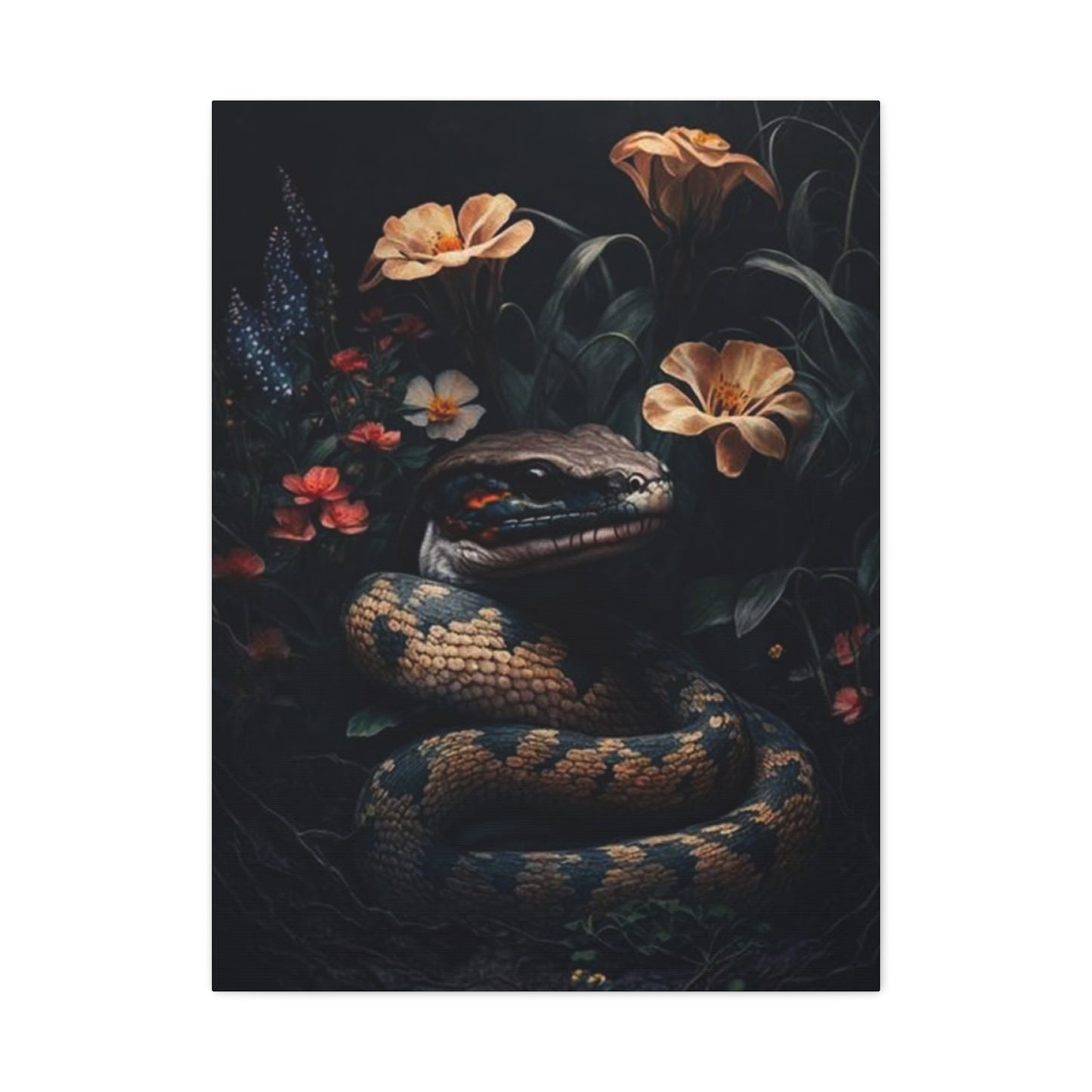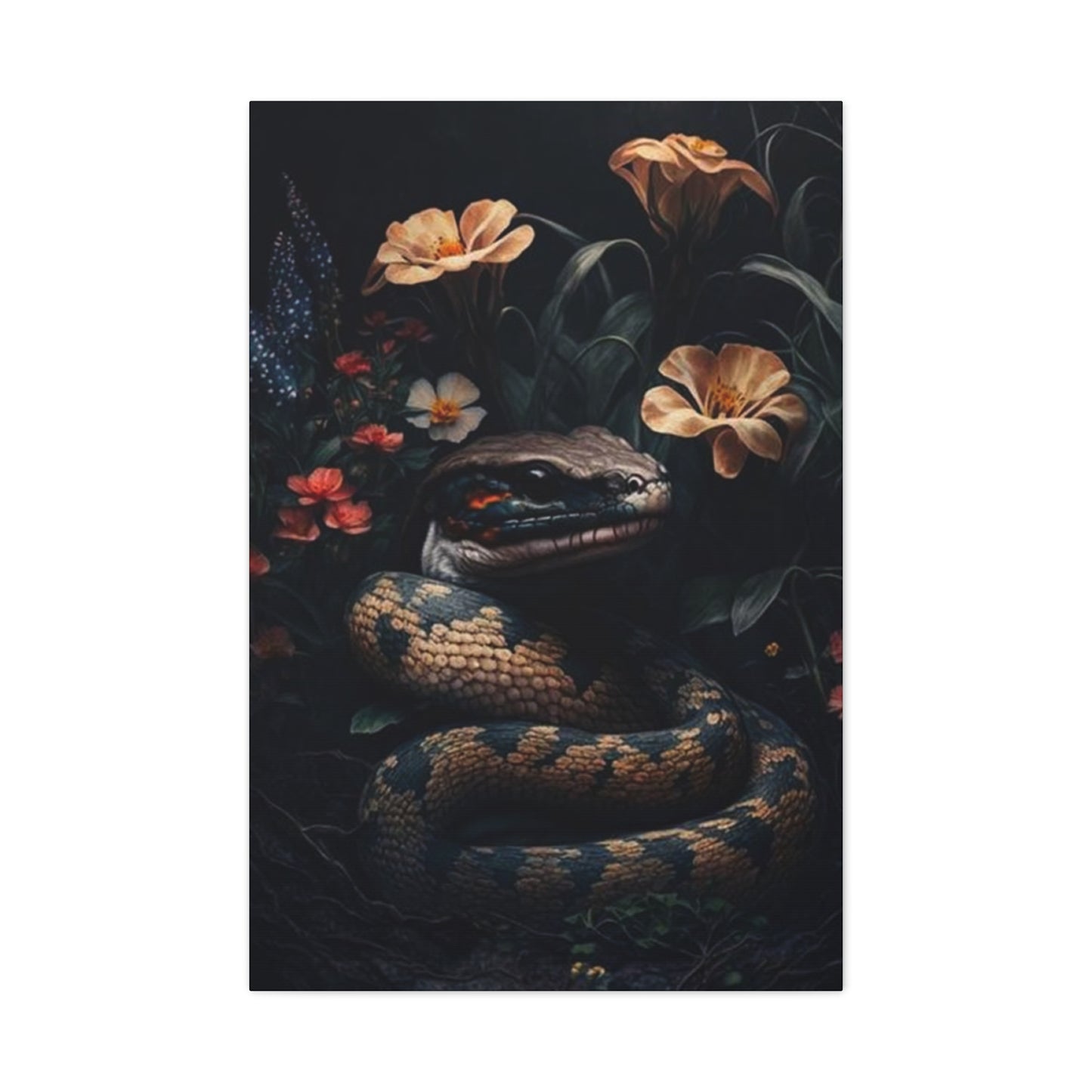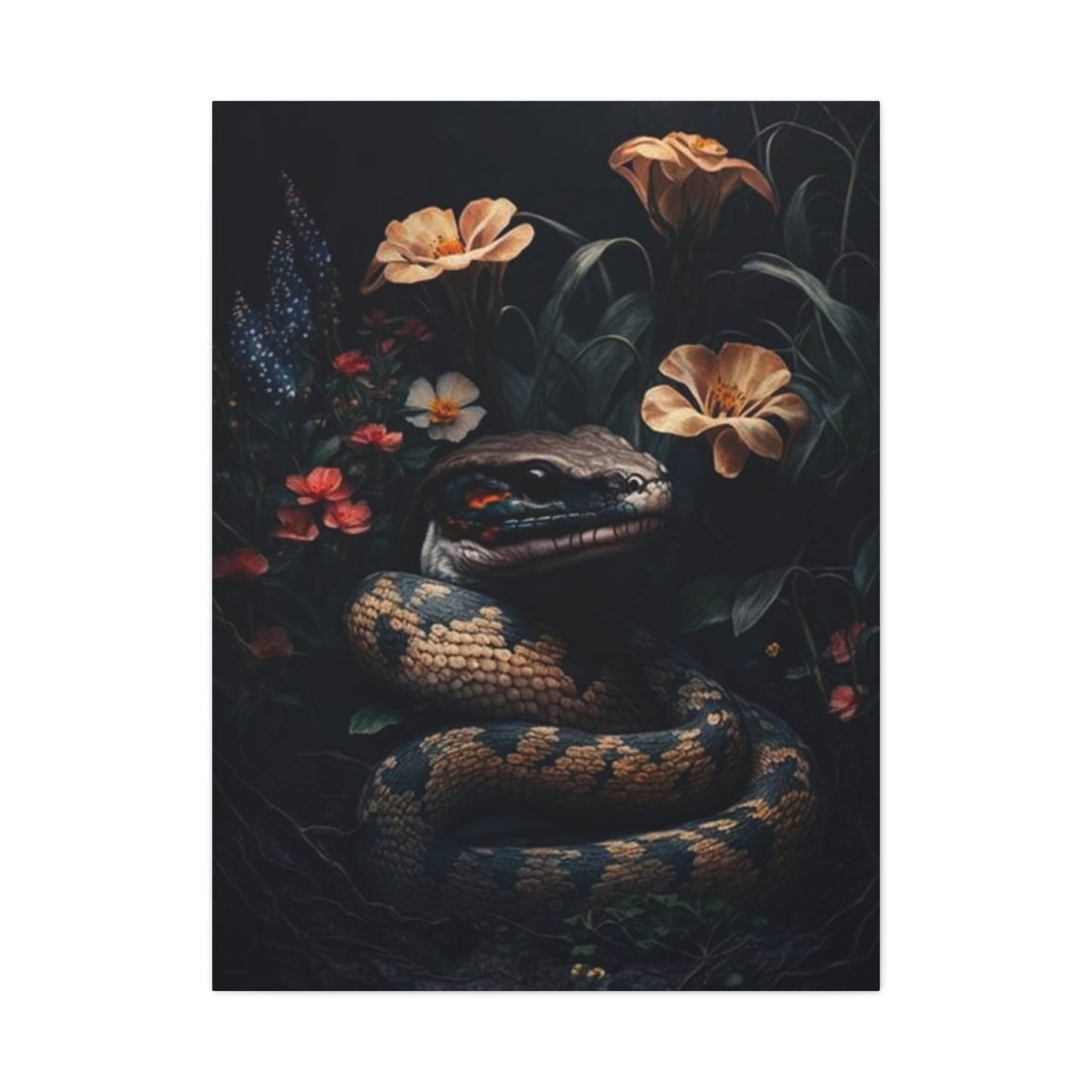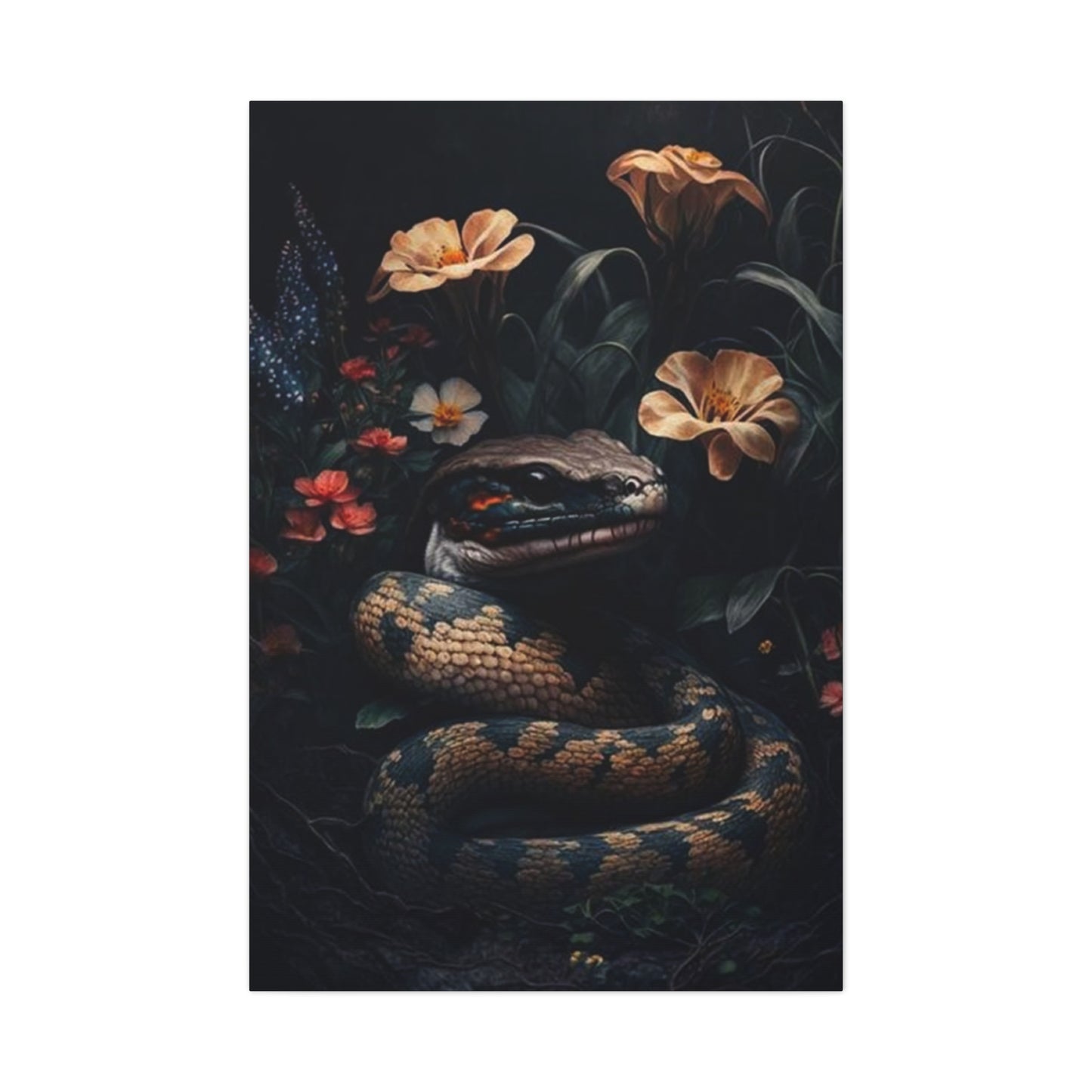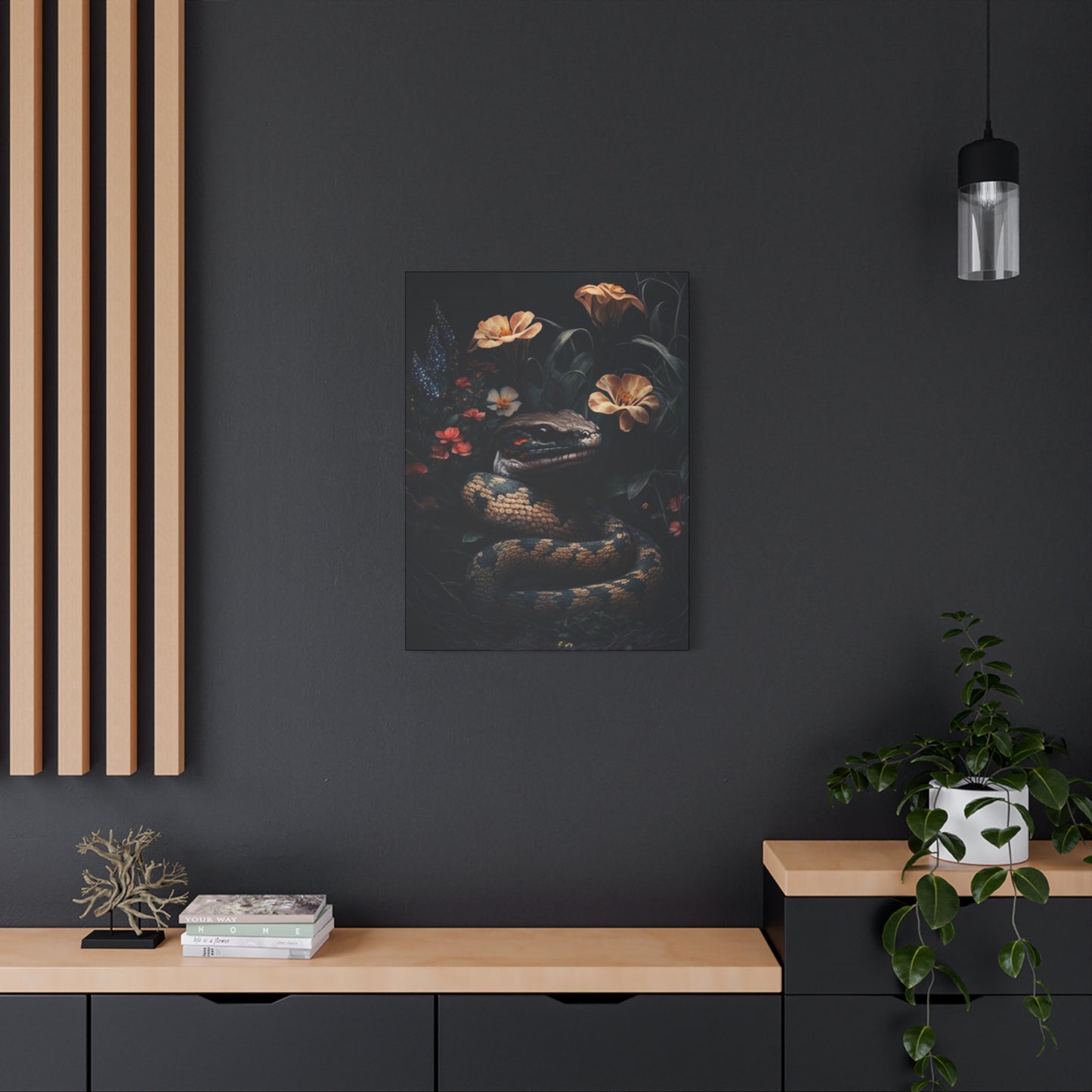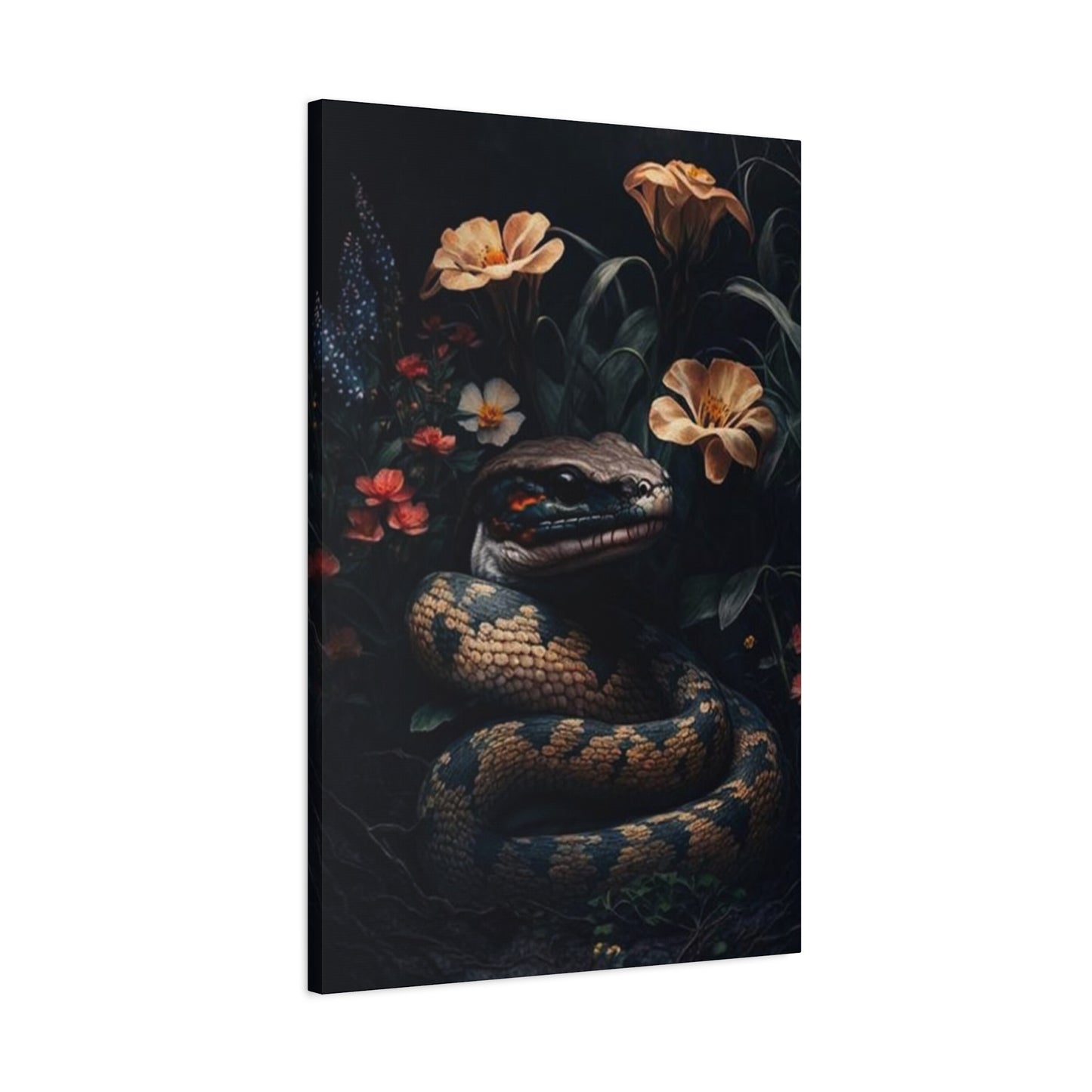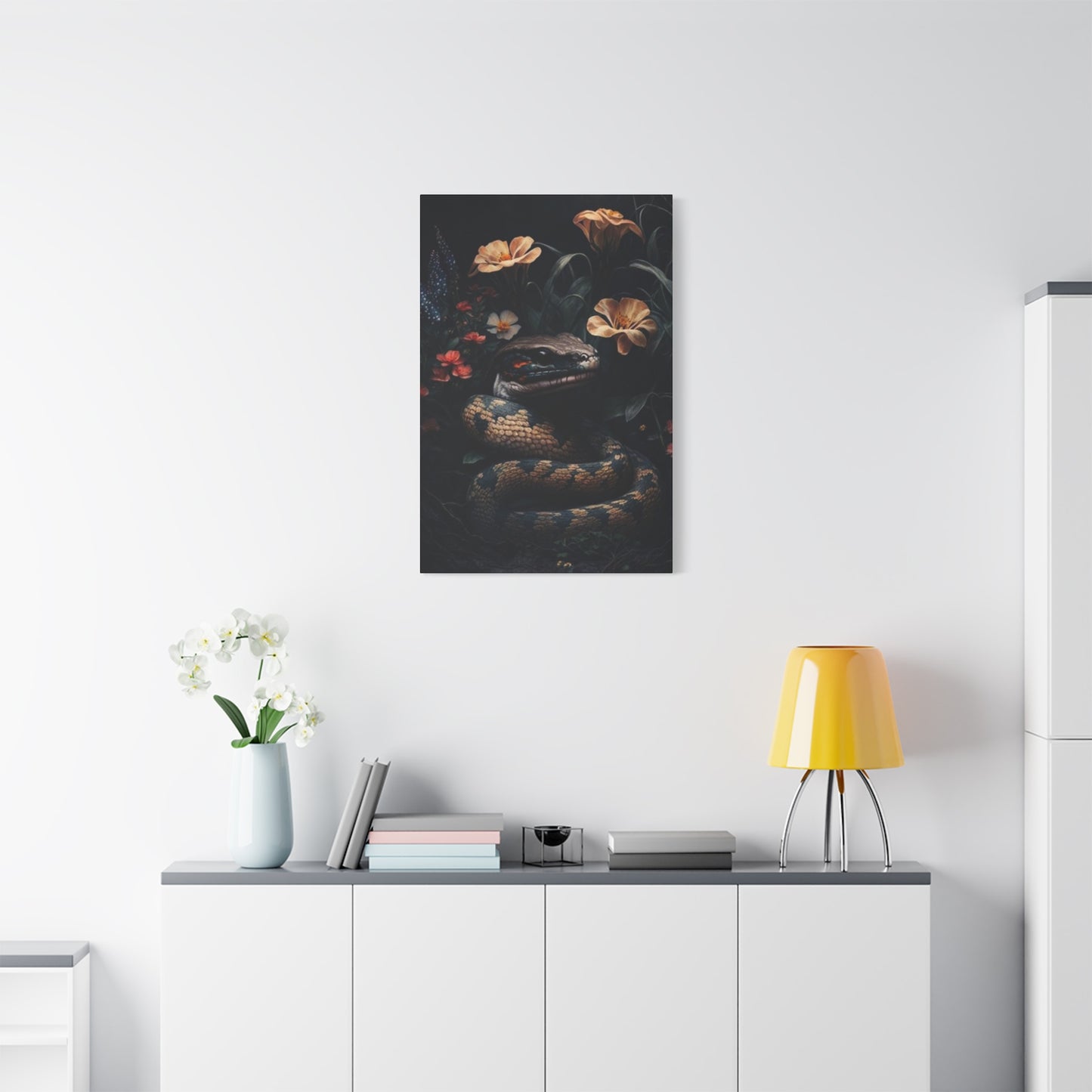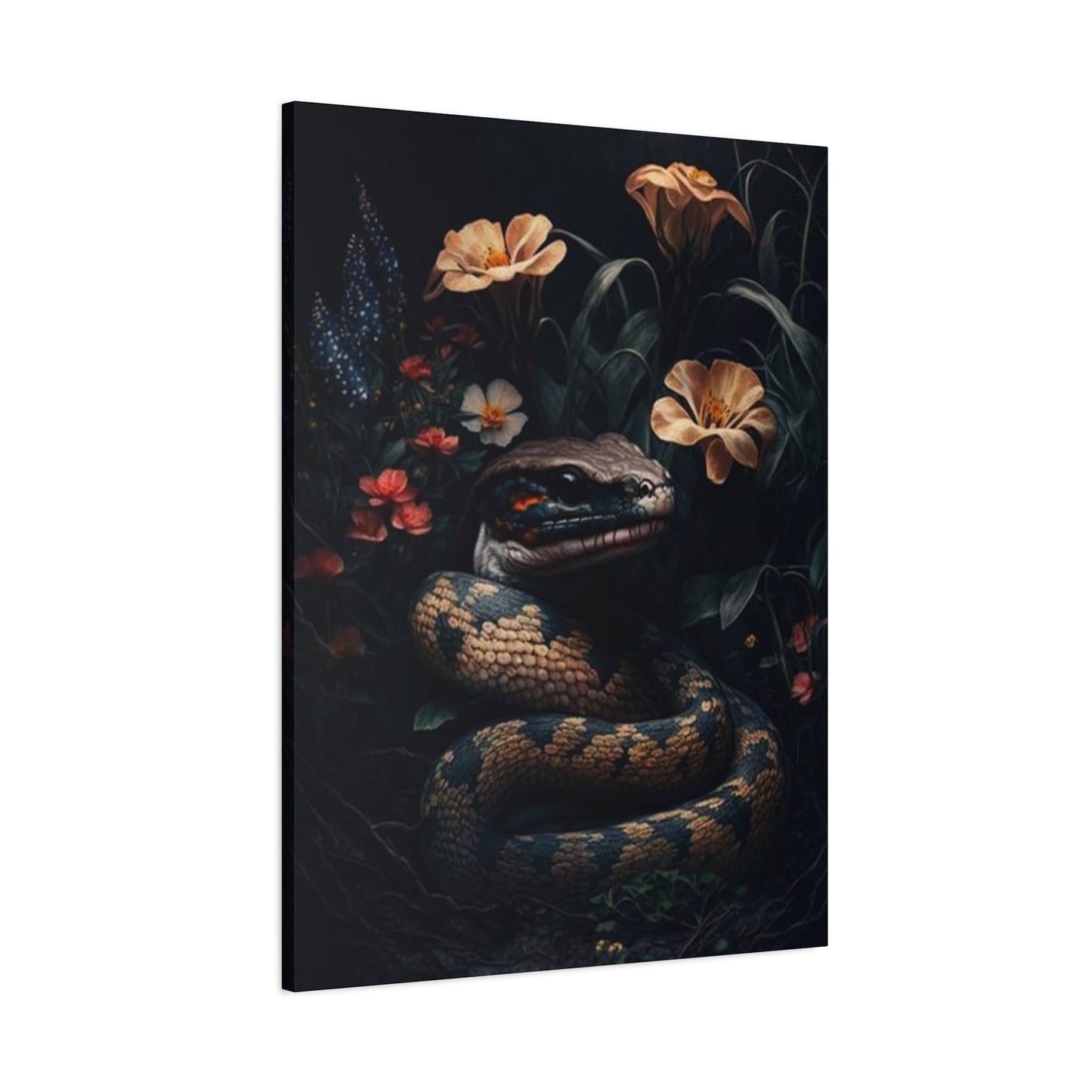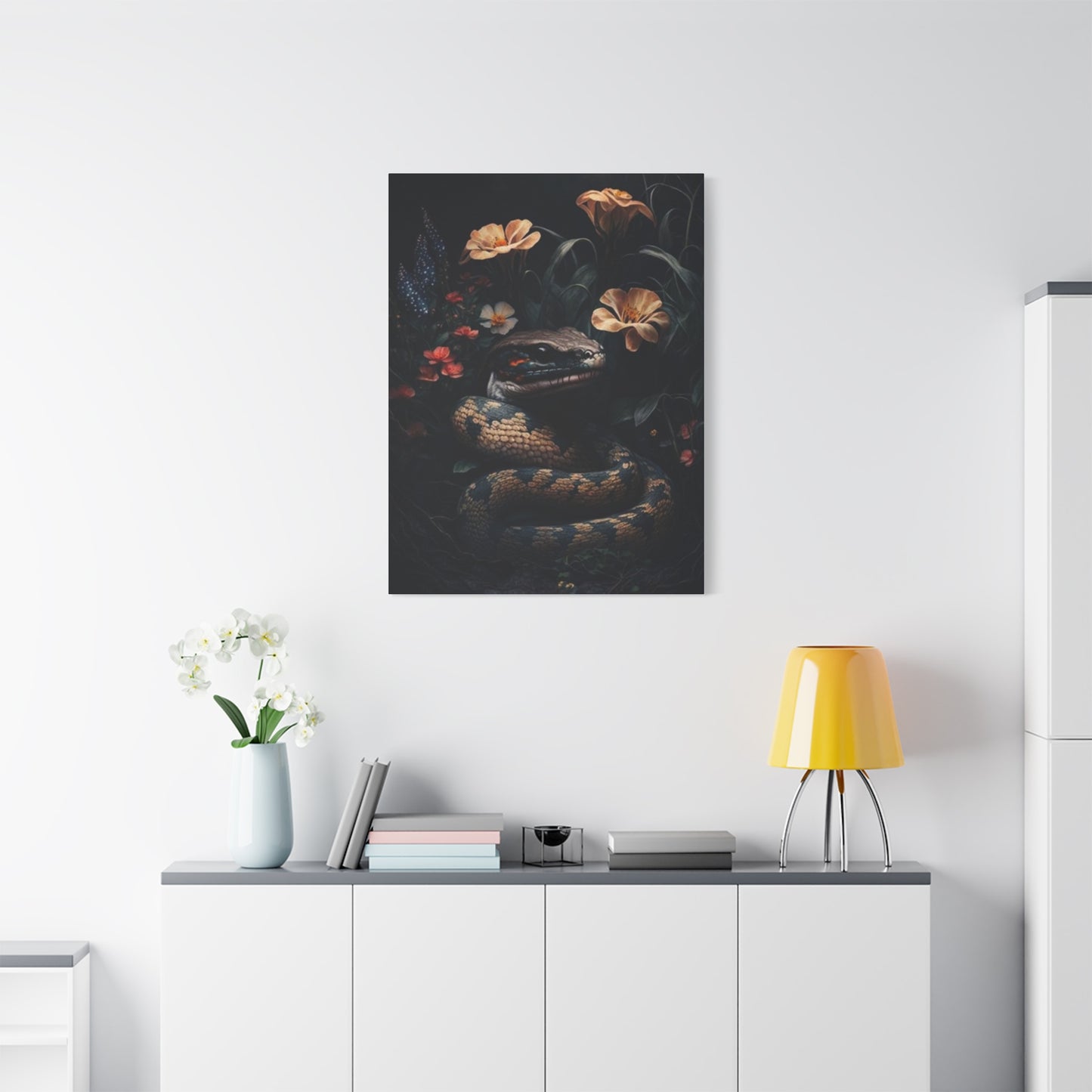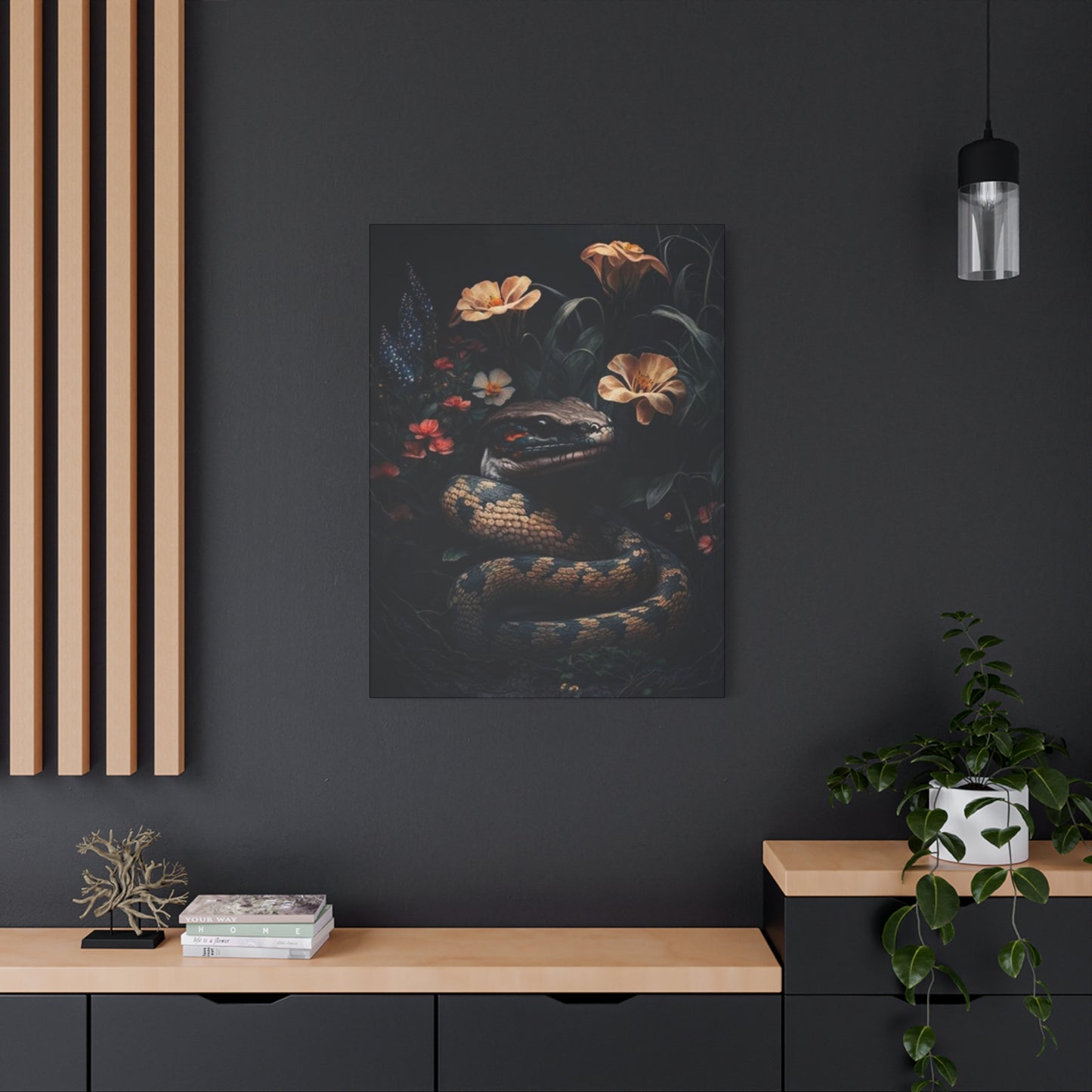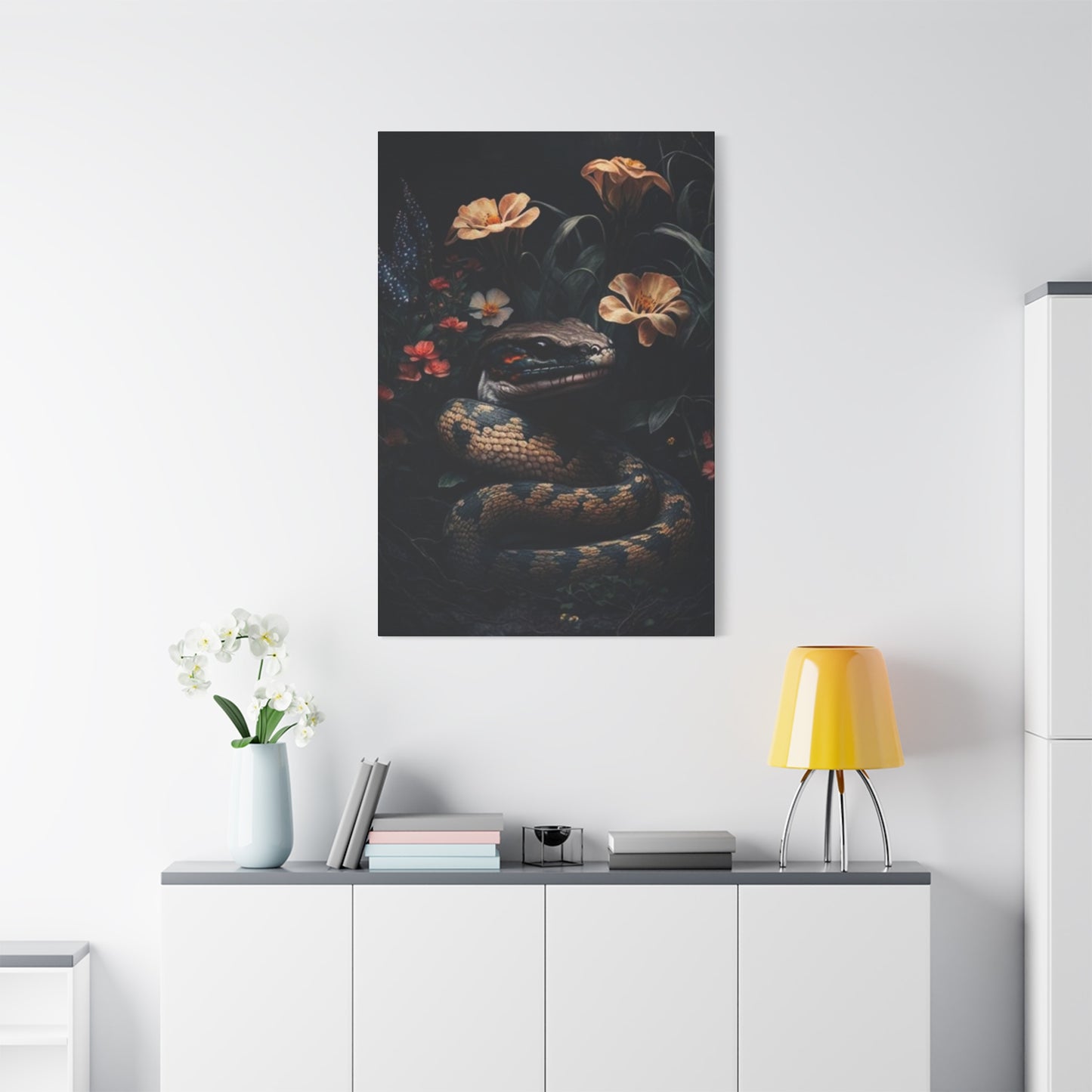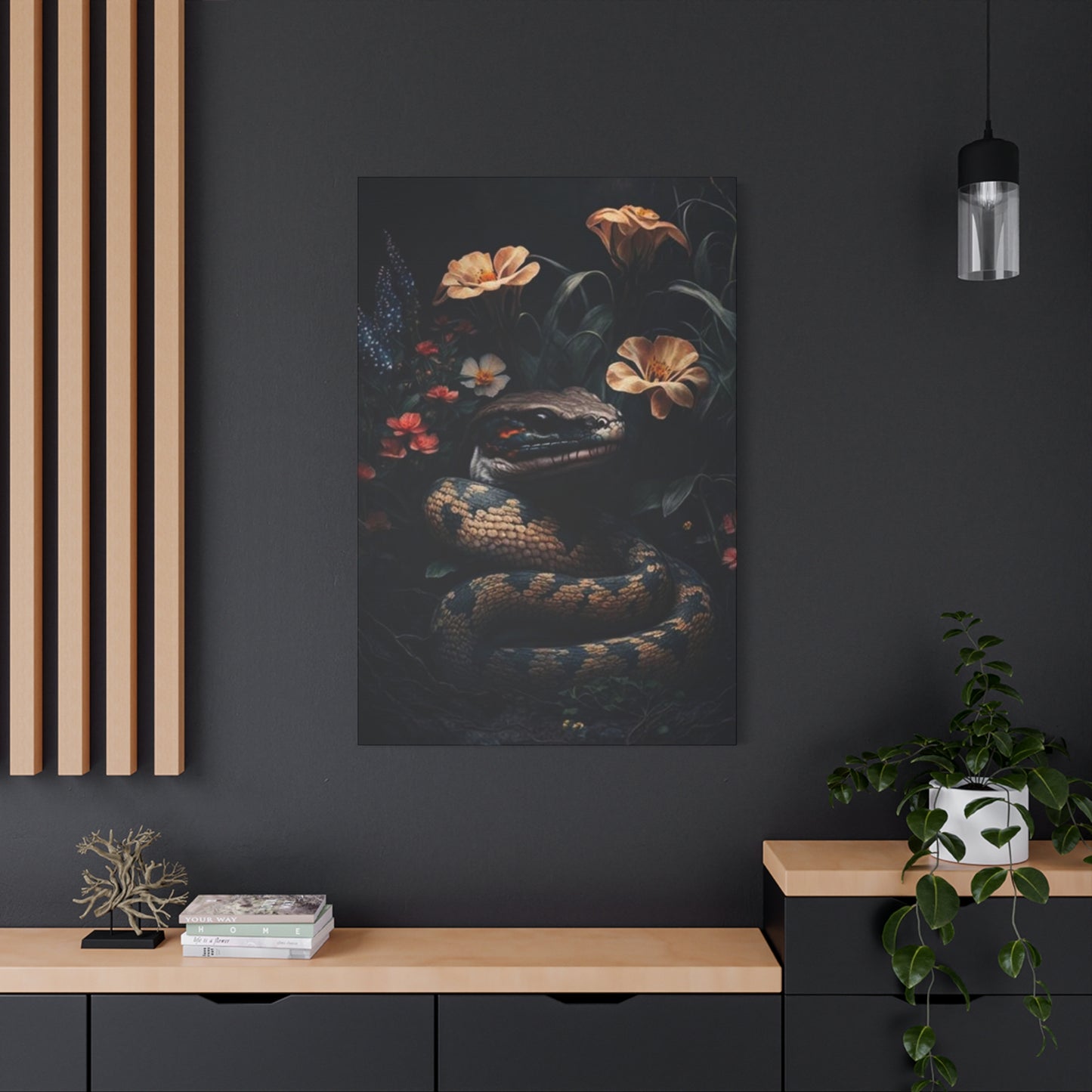Nature’s Contradictions: How Snake and Flower Wall Art Reflects Balance and Conflict
The combination of serpents and blossoms in artistic representations creates a captivating visual narrative that has fascinated art enthusiasts and interior designers for generations. This unique pairing brings together two seemingly opposite elements of nature, creating a harmonious balance that speaks to the duality of existence itself. When you incorporate artwork featuring these elements into your living spaces, you are inviting a conversation piece that transcends ordinary decoration and enters the realm of meaningful artistic expression.
The visual appeal of serpent imagery combined with delicate petals creates an immediate focal point in any room. This artistic fusion works exceptionally well in contemporary homes, bohemian spaces, and even traditional settings when styled appropriately. The contrast between the smooth, sinuous curves of the reptile form and the soft, organic shapes of petals creates a dynamic tension that draws the eye and holds attention. Whether rendered in bold, vibrant colors or subtle, monochromatic tones, this artistic combination offers versatility that few other decorative themes can match.
Interior designers have increasingly recognized the power of this symbolic pairing in creating spaces that feel both grounded and transformative. The serpent element brings an edge of mystery and ancient wisdom, while the botanical components soften the overall composition with natural beauty and gentle femininity. This balance makes such artwork suitable for various rooms in your home, from living rooms and bedrooms to meditation spaces and creative studios. The key lies in selecting pieces that resonate with your personal aesthetic while complementing your existing décor elements.
Decorative Wall Canvas Featuring Reptilian Forms and Botanical Elements
When selecting decorative pieces that showcase the union of reptilian forms and botanical beauty, understanding the artistic styles available becomes essential. Traditional representations might feature realistic renderings of serpents entwined with accurately depicted roses, lilies, or cherry blossoms. These pieces often showcase the technical skill of the artist and create a sense of natural wonder that brings the outdoors inside. The attention to detail in scales, textures, and petal formations can transform a simple canvas into a stunning centerpiece that commands attention and admiration.
Contemporary interpretations take a more abstract approach, using simplified forms and bold color palettes to create striking visual statements. These modern pieces might employ geometric patterns, watercolor effects, or digital art techniques to reimagine the classic pairing in fresh, innovative ways. The serpent might be represented through flowing lines and curves rather than detailed scales, while the botanical elements could be suggested through splashes of color and organic shapes rather than precise botanical accuracy. This contemporary approach appeals to those who prefer minimalist aesthetics or want artwork that feels current and on-trend.
The medium chosen for these artworks significantly impacts their visual effect and durability. High-quality canvas prints offer excellent color reproduction and can last for decades when properly cared for. The texture of canvas adds depth and dimension to the artwork, creating shadows and highlights that change with different lighting conditions throughout the day. Gallery-wrapped canvases, where the image extends around the edges of the frame, provide a polished, professional appearance that eliminates the need for additional framing. This presentation style works particularly well for contemporary and minimalist interiors where clean lines and uncluttered aesthetics are priorities.
Artistic Representations of Serpents Intertwined with Garden Blooms
The artistic tradition of depicting serpents alongside garden blooms draws from rich cultural and mythological sources spanning centuries and civilizations. In many ancient cultures, the serpent represented transformation, healing, and wisdom, while blooms symbolized beauty, growth, and the fleeting nature of life. When artists combine these elements, they create layered meanings that invite contemplation and personal interpretation. A serpent wrapped around a rose stem might suggest the thorny path to wisdom, while one emerging from lotus petals could represent spiritual awakening and enlightenment.
Different artistic movements have approached this subject matter with varying techniques and philosophies. Art Nouveau artists of the late nineteenth and early twentieth centuries often incorporated serpentine forms and botanical elements in their highly stylized, flowing compositions. Their work emphasized organic curves and natural forms, creating harmonious designs that celebrated the interconnectedness of all living things. Contemporary artists continue to draw inspiration from these historical approaches while infusing their work with modern sensibilities and techniques that speak to today's audiences.
The color palette selected for such artwork dramatically influences its emotional impact and suitability for different spaces. Deep jewel tones like emerald, sapphire, and ruby create dramatic, sophisticated pieces that work beautifully in formal living areas or as statement pieces in minimalist spaces. Softer pastel combinations of blush pink, sage green, and lavender produce gentler, more romantic compositions suitable for bedrooms or peaceful retreat spaces. Monochromatic approaches using various shades of a single color create elegant, cohesive pieces that integrate seamlessly into carefully curated color schemes. Black and white compositions offer timeless sophistication and work with virtually any décor style.
Canvas Artwork Showcasing the Union of Scaled Creatures and Petals
The technical aspects of creating high-quality canvas artwork featuring scaled creatures and petals require careful consideration of printing methods and material quality. Giclée printing, which uses archival-quality inks and specialized printers, produces museum-grade reproductions that capture subtle color variations and fine details with remarkable accuracy. These prints resist fading and deterioration far better than standard printing methods, ensuring your investment maintains its beauty for years to come. When shopping for such pieces, inquire about the printing method used and the expected lifespan of the inks to ensure you are purchasing a lasting piece of art.
The canvas material itself varies in quality and texture, affecting both the appearance and durability of the finished piece. Premium cotton canvas offers superior color absorption and a pleasing texture that adds depth to the artwork. Polyester blends provide excellent durability and resistance to environmental factors like humidity, making them ideal for climates with extreme weather conditions or for spaces like bathrooms where moisture levels fluctuate. The weight of the canvas, measured in ounces per square yard, indicates its thickness and durability. Heavier canvases generally provide better quality and longevity, though they also come at higher price points.
Proper stretching and mounting of canvas artwork requires skill and quality materials to ensure the piece hangs correctly and maintains its shape over time. Gallery-wrapped canvases stretched over sturdy wooden frames provide a professional presentation that requires no additional framing. The depth of the stretcher bars, typically ranging from three-quarters of an inch to two inches, affects the piece's visual impact on the wall. Deeper profiles create more dramatic shadows and give the artwork a floating appearance, while shallower depths offer a more traditional, understated look. Some artists and manufacturers wrap the image around the sides of the canvas, creating a finished appearance from all angles, while others print the image only on the front and leave the sides blank or colored in a solid tone.
Wall Hanging Designs Featuring Serpentine Forms Adorned with Botanical Beauty
The placement and presentation of wall hangings featuring serpentine forms adorned with botanical beauty significantly impact their effectiveness in your space. Consider the viewing distance when selecting the size of your artwork. Large-scale pieces work beautifully as focal points in spacious rooms with high ceilings, commanding attention from across the space and anchoring furniture arrangements. Smaller pieces suit intimate spaces or can be grouped together to create gallery walls that tell a cohesive visual story. The rule of thirds suggests that artwork should occupy roughly two-thirds to three-quarters of the width of the furniture piece below it, creating pleasing visual proportions.
Lighting plays a crucial role in how viewers perceive and appreciate your serpent-themed artwork. Natural light brings out the true colors and details of the piece but can also cause fading over time if the artwork receives direct sunlight for extended periods. Position such pieces on walls that receive indirect natural light, or use UV-filtering window treatments to protect your investment. Artificial lighting offers more control and can be used to create dramatic effects. Picture lights mounted above or below the artwork create focused illumination that highlights details and creates depth. Track lighting or adjustable spotlights allow you to direct light precisely where you want it, creating shadows and highlights that enhance the three-dimensional quality of the serpentine forms and botanical elements.
The height at which you hang your artwork affects its visual impact and the comfort of viewing it. The center of the piece should typically sit at eye level, approximately 57 to 60 inches from the floor, though this guideline should be adjusted based on the ceiling height and furniture arrangement in your space. In dining areas, where people view artwork while seated, hanging pieces slightly lower ensures they remain visible and engaging during meals. In stairways or hallways, follow the angle of the stairs or create a unified horizon line that guides the eye through the space. When hanging multiple pieces together, maintain consistent spacing between them, typically two to four inches, to create visual cohesion without making the arrangement feel cluttered.
Printed Canvases Displaying the Harmony Between Reptiles and Blossoms
The artistic composition of printed canvases displaying the harmony between reptiles and blossoms requires careful balance to create visually pleasing and meaningful pieces. Artists must consider the relationship between positive and negative space, ensuring neither element overwhelms the other while maintaining visual interest throughout the composition. The serpent's form might weave through and around the botanical elements, creating a sense of movement and flow that guides the viewer's eye across the canvas. Alternatively, the reptile might serve as a foundation or anchor point from which the blooms emerge, suggesting growth and transformation.
Texture plays an important role in creating depth and visual interest in these compositions. Even in two-dimensional artwork, artists can suggest texture through various techniques. Detailed rendering of scales creates a tactile quality that makes viewers want to reach out and touch the surface. Similarly, careful attention to the delicate structures of petals, stamens, and leaves adds realism and depth to the botanical elements. Some artists incorporate actual texture into their canvases through impasto techniques, applying paint thickly to create raised surfaces that catch light and cast shadows. Others use digital techniques to simulate texture, creating the appearance of brushstrokes or other surface qualities in printed reproductions.
The symbolic relationship between the reptilian and botanical elements can be emphasized through compositional choices. A serpent coiled protectively around a budding blossom suggests guardianship and potential. One emerging from beneath fully opened petals might represent hidden knowledge or the revelation of deeper truths. The direction of the serpent's movement, whether ascending or descending, spiraling or stretching linearly, affects the emotional tone of the piece. Upward movement often feels optimistic and energizing, while downward or circular motion can feel more contemplative and grounding. These subtle compositional choices allow artists to infuse their work with layers of meaning that resonate differently with each viewer.
Abstract Artistic Interpretations of Serpents Surrounded by Garden Flora
Abstract interpretations of serpents surrounded by garden flora offer exciting possibilities for those who prefer non-representational art or want pieces that spark imagination and interpretation. These works move away from realistic depiction, instead using color, shape, line, and form to evoke the essence of their subjects. A serpent might be suggested through a sinuous line that weaves across the canvas, while botanical elements appear as bursts of color or organic shapes that punctuate the composition. This approach allows for greater creative freedom and often results in pieces that work beautifully with a wider range of décor styles.
The emotional impact of abstract representations often surpasses that of realistic artwork because viewers bring their own experiences and interpretations to the piece. Without the constraints of realistic representation, artists can emphasize the feelings and concepts associated with serpents and blooms rather than their physical appearance. Bold, energetic brushstrokes might convey the dynamic power of the serpent, while soft, blended colors could evoke the gentle beauty of petals. The interplay between sharp, angular forms and soft, rounded shapes can create visual tension that mirrors the conceptual contrast between these natural elements.
Color takes on heightened importance in abstract representations, as it must work harder to convey meaning without the support of realistic forms. Artists might use unexpected color combinations to challenge viewers' assumptions and create fresh perspectives on familiar subjects. A serpent rendered in soft pinks and violets rather than traditional greens or browns becomes something new and thought-provoking. Botanical elements in bold blues and blacks feel mysterious and exotic rather than conventionally pretty. These unconventional choices transform familiar subjects into contemporary art pieces that feel innovative and original while maintaining their symbolic resonance.
Artistic Prints Celebrating the Beauty of Scaled Beings Among Petals
The celebration of scaled beings among petals in artistic prints reflects a growing appreciation for the often-misunderstood beauty of reptilian creatures. Many people harbor unfounded fears of serpents based on cultural conditioning or negative media portrayals. Artistic representations that present these creatures alongside universally beloved botanical elements help viewers see them in a new light. The juxtaposition encourages a reconsideration of preconceived notions and invites appreciation for the elegant forms and patterns found in serpent anatomy.
Different serpent species offer varying aesthetic qualities that artists can explore in their work. The bold, geometric patterns of certain species create strong visual impact and work well in graphic, contemporary compositions. The smooth, iridescent scales of others catch light beautifully and inspire works that emphasize shine and luminosity. Some species feature subtle, camouflage-like patterns that blend beautifully with botanical backgrounds, creating pieces where viewers must look closely to distinguish the serpent from its surroundings. This hide-and-seek quality adds an interactive element to the artwork, rewarding careful observation with discovery.
The botanical elements chosen to accompany the serpent also communicate specific meanings and aesthetic qualities. Roses, with their layered petals and thorny stems, create complexity and suggest the relationship between beauty and protection. Lilies, with their bold, trumpet-shaped blooms and strong symbolism across cultures, add elegance and spiritual depth to compositions. Cherry blossoms bring delicate beauty and references to the fleeting nature of life. Tropical blooms introduce vibrant colors and exotic appeal, while wildflowers add a natural, untamed quality. The artist's choice of botanical companion shapes the overall mood and message of the piece, making each combination unique and purposeful.
Decorative Home Pieces Featuring Entwined Serpents and Vibrant Blooms
Creating cohesive interior spaces with decorative pieces featuring entwined serpents and vibrant blooms requires thoughtful consideration of existing elements and desired atmospheres. These striking pieces work beautifully as anchor points for room designs, with other elements selected to complement and enhance their visual impact. When working with bold, colorful artwork, you might pull accent colors from the piece to use in throw pillows, area rugs, or decorative accessories. This approach creates visual harmony and makes the artwork feel integrated into the space rather than arbitrarily placed.
The style and era of your furniture influences how well serpent-themed artwork integrates into your space. Modern, minimalist furniture with clean lines and simple forms provides an excellent backdrop for artwork with complex details and rich colors. The simplicity of the furnishings allows the artwork to command attention without visual competition. Traditional furniture with ornate details and rich wood finishes pairs beautifully with classical representations that feature realistic rendering and traditional color palettes. Mid-century modern pieces with their organic forms and warm wood tones complement both realistic and abstract interpretations, particularly those that emphasize flowing lines and natural forms.
The overall color scheme of your room should guide your selection of serpent-themed artwork to ensure visual harmony. In rooms with neutral color schemes dominated by whites, grays, and beiges, vibrant artwork featuring bold colors adds energy and personality without overwhelming the space. The neutral backdrop allows the colors in the artwork to truly pop and become the focal point of the room. In spaces with existing bold colors, selecting artwork that incorporates those same hues creates cohesion, while pieces in complementary colors add visual interest through contrast. Monochromatic rooms benefit from artwork that either matches the dominant color in various shades or introduces a carefully selected accent color that energizes the space.
Canvas Displays Showcasing Graceful Serpent Forms with Rose Imagery
The pairing of graceful serpent forms with rose imagery carries particularly rich symbolic weight, as both elements feature prominently in mythology, literature, and cultural traditions worldwide. The rose, often considered the queen of blooms, represents love, passion, beauty, and sometimes secrecy or hidden knowledge. When combined with serpent imagery, which symbolizes wisdom, transformation, and duality, the resulting artwork becomes a meditation on the complex nature of beauty and knowledge. A serpent wrapped around a rose stem, for example, might represent the idea that beauty and wisdom often come with challenges, represented by the thorns.
Different rose colors add additional layers of meaning to these compositions. Red roses universally symbolize passionate love and desire, creating artwork with romantic and intense emotional resonance. White roses suggest purity and new beginnings, producing pieces with a lighter, more spiritual quality. Yellow roses represent friendship and joy, resulting in warmer, more approachable compositions. Black roses, though not occurring naturally, appear in artistic representations to symbolize mystery, farewell, or dramatic transformation. Artists can play with these color associations to create specific moods and messages in their work.
The stages of rose development incorporated into artwork also affect its symbolism and visual appeal. Tight buds suggest potential and new beginnings, creating compositions that feel hopeful and forward-looking. Partially opened blooms in various stages suggest process and ongoing growth, adding dynamic interest to the composition. Fully opened roses at their peak beauty emphasize the present moment and the fullness of experience. Wilting or falling petals introduce themes of impermanence and change, adding melancholic beauty to the work. Artists might incorporate roses at various stages within a single composition, creating a meditation on the cycle of life and the passage of time.
Artistic Wall Décor Representing Mystical Serpent and Botanical Fusion
The mystical qualities of serpent and botanical fusion in artistic wall décor tap into ancient spiritual traditions and contemporary metaphysical interests. Throughout human history, serpents have appeared in spiritual contexts as symbols of kundalini energy, healing power, transformation, and the connection between earthly and divine realms. Botanical elements, particularly specific sacred plants and blooms, carry their own spiritual significance. When artists combine these elements, they create visual representations of spiritual concepts that resonate with viewers seeking deeper meaning in their surroundings.
The concept of transformation lies at the heart of much serpent symbolism across cultures. The shedding of skin represents the release of old patterns and the emergence of renewed being. Artwork that captures this transformative quality often features serpents in dynamic poses suggesting movement and change, surrounded by blooms in various stages of opening or transformation. These pieces appeal to individuals experiencing personal growth or life transitions, serving as visual reminders of the natural cycles of change and renewal. Placing such artwork in meditation spaces, yoga studios, or personal retreat areas reinforces their contemplative and transformative qualities.
Healing imagery often incorporates the serpent wrapped around a staff, as in the Rod of Asclepius or the Caduceus, ancient symbols that remain associated with medicine and healing today. Contemporary artists reinterpret these traditional forms by replacing or supplementing the staff with flowering plants, particularly those known for medicinal properties. Lavender, with its calming properties, echinacea for immune support, or chamomile for relaxation might appear alongside the serpent, creating artwork that speaks to holistic health and the healing power of nature. Such pieces work beautifully in wellness centers, healing practices, or personal spaces dedicated to health and self-care.
Sophisticated Canvas Art Pairing Elegant Serpents with Delicate Petals
Sophistication in canvas art pairing elegant serpents with delicate petals emerges from careful attention to composition, color harmony, and execution quality. These refined pieces avoid cartoonish or overly decorative approaches, instead presenting their subjects with dignity and artistic integrity. The serpent appears as a creature of grace and power rather than something threatening or cute. The botanical elements receive treatment that honors their natural beauty without sentimentality. This balanced approach creates artwork suitable for refined interiors and collectors who appreciate subtlety and craftsmanship.
The color palette significantly influences the sophistication level of these pieces. Muted, complex colors like dusty rose, sage, terracotta, and charcoal create refined, mature compositions that feel timeless rather than trendy. These sophisticated color choices work beautifully in professional spaces, upscale homes, and anywhere a sense of understated elegance is desired. Jewel tones like deep emerald, sapphire, and burgundy bring richness and depth without feeling overly bright or casual. Even when working with brighter colors, sophisticated pieces show restraint, using bold hues strategically as accents rather than overwhelming the entire composition.
Composition in sophisticated artwork demonstrates clear intention and thoughtful design. Every element serves a purpose, with nothing included arbitrarily or as mere decoration. The relationship between the serpent and botanical elements feels natural and meaningful rather than forced or contrived. Negative space receives as much consideration as positive space, with careful attention to how empty areas balance and complement the detailed portions of the composition. The eye moves through the piece following a clear visual path created by the artist, rather than darting randomly around without direction. This compositional maturity distinguishes fine art from merely decorative pieces.
Wall Art Designs Showcasing Nature's Duality Through Serpent and Bloom
The concept of duality permeates existence, and artwork showcasing this principle through serpent and bloom imagery creates thought-provoking pieces that reward contemplation. The serpent represents aspects of nature often perceived as dangerous, mysterious, or threatening, while blooms embody beauty, gentleness, and accessibility. By bringing these contrasting elements together harmoniously, artists create visual metaphors for balance, integration, and the coexistence of seemingly opposite qualities. These pieces appeal to viewers who appreciate art that engages the mind as well as the eye.
Various dualities find expression in this artistic pairing. The contrast between danger and beauty appears when threatening serpents intertwine with delicate blooms, suggesting that dangerous things can possess beauty and beautiful things might harbor hidden threats. The relationship between death and life emerges in compositions where serpents, sometimes associated with venom and mortality, appear alongside blooms representing growth and vitality. This juxtaposition invites reflection on the interconnectedness of all aspects of existence and the impossibility of separating one from the other. The cycle of life contains both growth and decay, creation and destruction, and artwork that honors this reality feels honest and profound.
The balance between masculine and feminine energies also plays out in these compositions. In many symbolic systems, the serpent carries masculine or yang energy, representing action, power, and linear movement. Blooms often embody feminine or yin energy, suggesting receptivity, beauty, and cyclical patterns. Artwork that balances these energies creates visual harmony that feels complete and satisfying. The integration of these complementary forces speaks to psychological wholeness and the value of honoring all aspects of nature and self. Viewers seeking balance in their own lives often feel drawn to artwork that represents this integration.
Printed Canvas Artwork Featuring Serpentine Grace Among Garden Blossoms
The technical quality of printed canvas artwork featuring serpentine grace among garden blossoms determines its longevity and visual impact in your space. High-resolution printing captures fine details in scales, petal textures, and subtle color variations that bring the artwork to life. When examining potential purchases, look for prints that maintain clarity and detail when viewed up close, not just from across the room. Pixelation, banding, or muddy colors indicate lower-quality printing that will disappoint over time. Reputable sellers provide detailed specifications about resolution and printing methods, allowing informed purchase decisions.
The protective coatings applied to canvas prints affect both their appearance and durability. UV-resistant coatings protect the inks from sun damage, preventing the fading and color shifts that can occur when artwork receives natural light exposure. These coatings allow you to display your pieces with confidence, knowing they will maintain their beauty for years. Water-resistant coatings protect against moisture damage, making prints suitable for bathrooms, kitchens, or humid climates. Some coatings add a subtle sheen that enhances colors and adds depth to the image, while others maintain a completely matte finish that minimizes glare and reflections. Consider your display location and personal preferences when selecting coated prints.
The backing and hanging hardware provided with canvas prints influence ease of installation and long-term stability. Quality pieces include sturdy backing boards that prevent the canvas from warping or sagging over time. Pre-installed hanging hardware, such as D-rings or wire, should be securely attached and appropriately rated for the weight of the piece. Some manufacturers include corner protectors that prevent damage during shipping and installation. Attention to these practical details indicates overall quality and care in production. Pieces lacking proper hardware or protective elements might cost less initially but can lead to frustration and additional expenses when you need to add proper mounting systems or replace damaged artwork.
Symbolic Art Pieces Combining Serpent Iconography with Botanical Elements
The symbolic richness of art pieces combining serpent iconography with botanical elements draws from millennia of human culture, mythology, and spiritual practice. Ancient civilizations worldwide recognized the serpent as a powerful symbol appearing in creation myths, healing practices, and representations of divine power. The specific symbolic associations vary across cultures, but common threads include transformation, wisdom, healing, fertility, and the connection between earthly and spiritual realms. Understanding these symbolic associations enhances appreciation for artwork incorporating serpent imagery and helps in selecting pieces that resonate with personal beliefs and values.
In many Eastern traditions, the serpent connects to kundalini energy, the powerful life force believed to reside at the base of the spine. Artwork depicting serpents rising or spiraling upward might reference this concept of spiritual awakening and the ascension of consciousness through the body's energy centers. Pairing the ascending serpent with lotuses, which symbolize enlightenment and purity in Buddhist and Hindu traditions, creates particularly resonant imagery for those following Eastern spiritual paths. Such pieces work beautifully in meditation spaces or areas dedicated to spiritual practice and contemplation.
Western traditions also offer rich serpent symbolism, from the serpent in the Garden of Eden representing temptation and knowledge, to Asclepius's serpent-wrapped staff symbolizing healing and medicine. Artwork referencing these traditions might appeal to viewers with Judeo-Christian backgrounds or those working in healthcare fields. The combination of serpent and apple blossoms, for instance, creates clear allusion to the Biblical narrative while adding beauty and artistic interest. Medical professionals might appreciate artwork combining the traditional medical serpent with healing plants like echinacea, calendula, or St. John's wort, creating personal connection between their vocation and their living space.
Ethereal Wall Canvas Displaying Serpents Decorated with Ornamental Flowers
Ethereal quality in wall canvas displaying serpents decorated with ornamental flowers emerges from artistic techniques that emphasize lightness, translucency, and dreamlike beauty. These pieces often employ soft focus, gentle color transitions, and luminous quality that makes the subjects appear to glow from within. The serpent and botanical elements might seem to float in undefined space rather than being grounded in realistic settings. This approach creates artwork that feels meditative and peaceful, transforming potentially intimidating subjects into objects of delicate beauty.
Watercolor techniques, whether traditional or digitally simulated, contribute to ethereal quality through their characteristic soft edges and flowing color transitions. The medium's transparency allows layers of color to interact, creating complex, luminous effects that feel light and airy. Serpents rendered in watercolor lose their potentially threatening quality, becoming instead graceful, flowing forms that dance across the composition. Botanical elements in watercolor maintain botanical accuracy while gaining softness and romance, their petals appearing almost translucent and glowing with inner light.
The use of white space and minimal color palettes enhances ethereal quality in these compositions. Rather than filling every inch of canvas with detail and color, ethereal pieces allow breathing room, with subjects floating in fields of white or very pale color. This approach feels modern and fresh while creating a sense of calm and spaciousness that benefits smaller rooms or minimalist interiors. The serpent and blooms become precious jewels displayed against clean backgrounds, each detail rendered with care and intention. Viewers feel invited to approach these pieces quietly and contemplate them peacefully rather than being overwhelmed by visual information.
Contemporary Canvas Prints Showcasing Serpentine Beauty with Botanical Accents
Contemporary approaches to canvas prints showcasing serpentine beauty with botanical accents embrace current design trends while honoring the timeless appeal of these natural subjects. Modern geometric interpretations fragment and reassemble the serpent form using angular shapes and bold lines, creating dynamic compositions that feel fresh and current. The botanical elements might be simplified to their essential forms or presented as stylized graphics rather than realistic renderings. These contemporary treatments appeal to younger collectors and those furnishing modern spaces with clean lines and minimalist aesthetics.
Digital art techniques open new possibilities for contemporary serpent-themed artwork. Artists can create impossibly smooth gradients, perfectly symmetrical patterns, and effects that would be difficult or impossible to achieve with traditional media. Digital manipulation allows for creative color treatments, such as neon hues against dark backgrounds or holographic effects that shift with viewing angle. These digital-native pieces feel appropriate for modern, tech-savvy spaces and appeal to collectors who appreciate innovation in artistic media. The distinction between digital and traditional art continues to blur as printing technology advances, allowing digital works to be presented with the same physical presence as traditional paintings.
Mixed-media approaches combine photographic elements, digital manipulation, traditional drawing or painting, and graphic design elements into cohesive compositions that feel layered and complex. A photograph of a real serpent might be combined with hand-drawn botanical illustrations and digital color overlays, creating artwork that draws from multiple artistic traditions simultaneously. These hybrid pieces reflect contemporary life's multimedia nature and appeal to viewers who appreciate complexity and innovation. The combination of techniques adds visual interest and depth, inviting extended viewing as the eye discovers new details and relationships between elements.
Large-Scale Wall Décor Featuring Bold Serpent and Blossom Compositions
Large-scale wall décor featuring bold serpent and blossom compositions creates dramatic focal points that anchor interior spaces and command attention. These substantial pieces, ranging from several feet to wall-sized proportions, transform rooms and influence how all other elements relate to each other. When selecting oversized artwork, careful attention to scale relationships ensures the piece enhances rather than overwhelms your space. The ceiling height, room dimensions, and furniture scale all factor into determining appropriate artwork size.
The visual impact of large-scale serpent-themed artwork depends partly on the boldness of the design itself. Simple, graphic compositions with strong lines and limited color palettes maintain clarity even at large scales, creating powerful statements that remain readable from across large rooms. More detailed, complex compositions reward closer inspection, revealing layers of information and inviting extended viewing. Consider how you and others will typically view the piece when deciding between bold simplicity and intricate detail. Artwork in formal living rooms or offices where people might stand at a distance benefits from bold, clear design. Pieces in bedrooms or intimate spaces where viewers spend extended time at close range can support more complexity.
Installation of large-scale pieces requires careful planning and often professional assistance. The weight of oversized canvas prints necessitates secure hanging systems that distribute load across multiple points rather than relying on a single nail or hook. Wall studs provide the most secure mounting points, though specialized heavy-duty wall anchors designed for drywall or plaster can support substantial weight when studs aren't optimally located. Many large pieces come in multiple panels designed to hang together, creating expansive compositions while keeping individual pieces manageable in size and weight. These multi-panel installations require careful alignment and spacing to create the intended effect.
Minimalist Canvas Art Pairing Simple Serpent Forms with Single Blossoms
Minimalist approaches to canvas art pairing simple serpent forms with single blossoms embrace the philosophy that less is more, creating powerful impact through restraint and careful editing. These pieces strip away everything except essential elements, presenting simplified serpent forms and single blooms or small botanical clusters against clean backgrounds. The resulting artwork feels calm, focused, and contemporary, perfectly suited to minimalist interiors and viewers who appreciate contemplative simplicity.
The artistic challenge in minimalist work lies in determining what to include and what to eliminate while maintaining interest and meaning. Every line, curve, and color choice carries increased weight when few elements populate the composition. The serpent's form must be readable and elegant with minimal detail, suggesting the creature's essence through curve and gesture rather than elaborate rendering. The botanical element, often a single bloom or branch, must balance the serpent visually while adding necessary color or detail contrast. The relationship between these simplified elements becomes the composition's focus, with negative space playing an active role in the overall design.
Color treatment in minimalist serpent-themed artwork typically follows one of several approaches. Monochromatic pieces using various values of a single color create sophisticated, cohesive compositions that integrate easily into carefully planned interiors. Limited palettes of two or three colors provide enough variety for visual interest while maintaining the restraint characteristic of minimalism. Some pieces employ a primarily neutral palette with a single accent color drawing the eye to specific elements or creating focal points. The background color choice significantly impacts the overall feel, with white or very light backgrounds creating airy, open compositions, while dark backgrounds add drama and make subjects appear to float or glow against the void.
Traditional Style Wall Art Celebrating Serpents Wrapped in Flowering Vines
Traditional artistic styles celebrating serpents wrapped in flowering vines draw inspiration from historical art movements and classical techniques. These pieces often reference Art Nouveau with its characteristic organic flowing lines, natural subjects, and decorative qualities. The serpent and vines intertwine in complex, ornamental patterns that fill the composition, creating rich visual tapestries that reward careful examination. Traditional rendering techniques emphasizing realistic detail and skillful execution appeal to collectors who appreciate craftsmanship and historical artistic approaches.
The color palettes in traditional serpent-themed artwork often reflect historical preferences for rich, saturated hues and careful color harmony. Deep greens, burgundies, golds, and navy blues create compositions that feel timeless and sophisticated. These classic color combinations work beautifully in traditional interiors featuring wood furniture, oriental rugs, and formal arrangements. The colors age well, avoiding the tendency of some contemporary palettes to quickly feel dated. Subtle color variations and careful shading create depth and dimension, giving subjects three-dimensional presence on the two-dimensional canvas.
Compositional approaches in traditional work typically embrace balance and harmony over edgy asymmetry or intentional visual tension. The serpent might form symmetrical patterns as it winds through flowering vines, or the composition might achieve balance through careful distribution of visual weight even if not strictly symmetrical. Borders or frames within the composition itself often appear, referencing historical decorative arts and creating contained, finished-feeling works. These framing elements might consist of additional botanical motifs, geometric patterns, or simply darker bands of color that define the composition's edges. The overall effect feels complete and polished, with every element in its proper place.
Bohemian Style Canvas Featuring Free-Spirited Serpent and Wildflower Designs
Bohemian aesthetics in canvas featuring free-spirited serpent and wildflower designs embrace eclecticism, vibrant color, and unconventional beauty. These pieces often incorporate multiple patterns, unexpected color combinations, and layered imagery that creates visual richness and complexity. The serpent might be decorated with patterns rather than realistic scales, and wildflowers in various stages of bloom might fill the composition in naturalistic but exuberant arrangements. Bohemian serpent art appeals to free spirits and individuals who resist conventional decorating rules in favor of personal expression and collected charm.
The color approach in bohemian pieces tends toward the bold and joyful, mixing warm and cool tones freely and embracing contrast. Sunset oranges, fuchsias, turquoise, and golden yellow might all appear in a single composition, held together by the confidence of the design rather than traditional color theory. This fearless approach to color creates artwork that energizes spaces and lifts moods. The colors might be somewhat saturated and bright without being harsh, maintaining warmth and accessibility despite their boldness. Metallic accents in gold or copper often appear, adding luminosity and richness that catches light and adds dimension.
Conclusion
Snake and flower wall art captures one of the most compelling paradoxes in nature—the coexistence of beauty and danger, creation and destruction, serenity and tension. These pieces embody the eternal dance between opposites, offering a rich visual metaphor that mirrors the human experience itself. Within a single composition, the soft petals of a flower intertwine with the sleek, coiled form of a serpent, creating an image that feels both alluring and unsettling. This delicate tension between harmony and threat makes snake-and-flower-themed art one of the most evocative forms of contemporary nature-inspired décor, capable of transforming interiors into spaces of reflection, mystery, and aesthetic intrigue.
At its core, snake and flower wall art serves as a symbolic exploration of duality. The flower traditionally represents purity, innocence, and life’s fleeting beauty, while the snake embodies wisdom, temptation, and transformation. When these two symbols are juxtaposed, they form a visual dialogue that goes beyond mere decoration—it becomes a statement about the nature of existence. The serpent winding through blossoms might suggest the intrusion of chaos into order, or the awakening of power within fragility. This interplay allows each viewer to find personal meaning in the composition, whether it’s about balance, rebirth, seduction, or survival.
From an interior design perspective, snake and flower artworks offer striking versatility. In modern minimalist settings, monochrome or metallic prints emphasize their sculptural elegance and conceptual depth. In bohemian or eclectic interiors, richly colored pieces—featuring vibrant blooms and intricately patterned serpents—infuse spaces with life and drama. These artworks pair beautifully with both light and dark color palettes, making them suitable for a variety of moods: a subdued floral snake print can introduce quiet sophistication, while a bold, high-contrast design can become a powerful focal point in a living room, office, or bedroom.
Lighting plays an especially important role in displaying such pieces. Soft, diffused illumination brings out the delicate textures of petals and scales, enhancing the sense of realism and dimension. On the other hand, directional or spotlight lighting can intensify the artwork’s dramatic contrasts, heightening the tension between serenity and menace that defines this genre. Whether printed on canvas, metal, or acrylic, snake and flower wall art invites a tactile engagement with its textures—smooth against rough, light against shadow—symbolizing the constant push and pull between opposing forces.
Symbolically, the snake and flower motif draws from a long lineage of myth and philosophy. In many cultures, snakes represent transformation, healing, and eternal cycles—shedding their skins as an emblem of renewal. Flowers, conversely, symbolize transience, beauty, and emotional expression. Together, they illustrate the impermanence of life and the balance necessary for growth. In art and design, this combination often hints at moral complexity or spiritual awakening. It encourages contemplation of how beauty and peril, attraction and restraint, coexist within the natural and emotional worlds. The result is not a clash, but a conversation—an acknowledgment that one cannot exist without the other.
Aesthetic appeal aside, snake and flower wall art brings psychological depth into interior spaces. It reminds viewers that life’s contradictions—love and loss, calm and chaos—are essential to its beauty. When displayed in a home or workspace, such artwork becomes a mirror for human emotion: the calm observer can appreciate the delicacy of the flowers, while the more introspective viewer might be drawn to the snake’s sinuous strength. The art doesn’t tell us what to feel; it asks us to engage, to interpret, and to find our own balance between admiration and caution.
In contemporary interior design, this genre is also prized for its ability to fuse natural symbolism with modern aesthetics. Artists frequently experiment with digital illustration, abstract realism, or surrealist fusion, blending botanical textures with geometric or dreamlike compositions. The result is wall art that feels timeless yet daring—perfect for those who want their décor to spark conversation while maintaining a refined sense of beauty. When paired with natural materials like wood, linen, or marble, the art resonates even more deeply, reinforcing the connection between human spaces and organic forms.
Ultimately, snake and flower wall art is far more than a visual curiosity—it is a meditation on existence. It reminds us that harmony is not the absence of conflict but the balance achieved through it. In their intertwining forms, we find a story of contrast, resilience, and evolution—a message that beauty is often born from tension, and that fragility and strength are forever intertwined.By embracing these artworks in our interiors, we celebrate the truth that nature’s contradictions are not flaws to be resolved, but wonders to be admired—each coil, petal, and shadow a reminder that life’s most captivating moments emerge from the meeting of light and darkness.

















